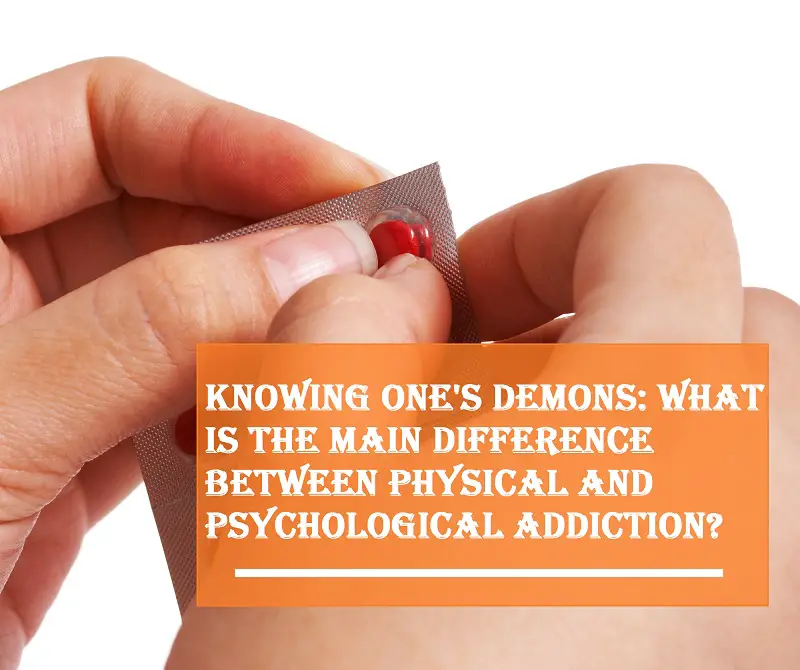Addiction is either physical or psychological. The type of addiction the individual is experiencing defines how they are treated.
Addiction can lead to risky behaviors and the destruction of families. Each type of addiction has differing signs and behavior patterns.
Identifying the type of addiction is the first step to finding the right path to recovery.
Understanding the difference between physical and psychological addictions shows what the individual can expect when seeking professional help.
Understanding What Physical Addiction is
Physical addiction is defined by a physiological need to use drugs or alcohol.
When the addict stops using, they go through several physiological changes that are devastating and often painful.
The body has adjusted to using the substance and therefore needs the substance.
As the individual becomes addicted to the substance, they develop a tolerance and slowly become dependent on it and how it has changed their body. As their tolerance grows, the addict needs more of the substance to achieve their high.
As the addict becomes more addicted to the substance, they use larger quantities until the addict faces emergency situations.
When it comes to alcoholics, they face higher than average alcohol consumption to the point where they could die from alcohol poisoning or develop cirrhosis of the liver.
When it comes to controlled substances, the addict could build up a tolerance that leads to an overdose or death.
The physical need to use becomes so overwhelming for the addict and if they don’t the physical effects are horrible for them.
Individuals who want to learn more about how to get help with a physical addiction can visit harrishousestl.com for more information now.
What Happens to Patients With Physical Addiction During Detox?

During detoxification, the addict or alcoholic will experience severe physical withdrawal symptoms.
The individual experiences nausea, vomiting, diarrhea, anxiety, and insomnia.
Depression, agitation, runny nose, and even tremors are possible physical withdrawal symptoms the individual could have during detox.
Since there is a higher risk of dehydration and life-threatening situations, it is recommended that the individual undergo detoxification through inpatient care and is monitored carefully.
Identifying Psychological Addiction
Psychological addiction is caused by changes in the brain caused by addiction.
As someone becomes addicted to alcohol or controlled substances, they experience severe changes in their brain’s structure and brain function.
Essentially, the addiction causes a mental disorder that requires treatment for the mental disorder to fight the addiction. Treatment for addiction requires additional help with depression and anxiety.
With psychological addictions, the individual’s mood changes if they don’t use it, and they become mentally overwhelmed.
This leads to criminal and risky behavior patterns to get the substance and achieve the high need to stop the urge to use.
The brain changes change the way the individual thinks and behaves. They will become a completely different person and won’t behave as they would before the addiction started.
When a person has a psychological addiction, they are more likely to try to barter to get a controlled substance or alcohol. They often experience self-deception where they believe they can control their addiction and as long as they don’t use over a predetermined amount that they don’t have an addiction.
It is these signs that indicate a more severe addiction and require faster access to professional services.
Understanding the Signs of Each

The signs of physical addiction require the individual to use to avoid negative physical symptoms caused by withdrawal.
Physical addiction can happen to individuals who take prescription pain medications if they must take them longer than a few weeks.
The family will notice physical changes such as dilated pupils, weight loss, a general look of illness, and some addicts with stop grooming and bathing properly. The individual will become shakey and nervous due to physical symptoms.
The signs of psychological addiction start with paranoia and a need to try to hide the addiction from their family.
Since it is psychological and a mental disorder, the individual will find ways to explain physical signs of addiction and try to avoid getting caught.
They will use drugs or drink when their family isn’t around. When the addiction becomes obvious to the family, the individual has neglected their children or other responsibilities.
In some cases, the family doesn’t come to the realization that their loved one has a problem until their loved one gets in trouble with the law.
With a psychological addiction, the individual continues to use it when they know that they have a serious illness related to their addiction.
They will continue to use when after a doctor diagnosis them with liver disease. They also have difficulties with interpersonal communication and relationships.
These inner conflicts prevent individuals from maintaining stable relationships with romantic partners and even friends.
The individual is more focused on using and hiding the fact that they are using to concentrate on more profound connections and remaining healthy.
What is the Difference in How Each Addiction is Treated?
With a physical addiction, the individual must undergo detoxification first to eliminate the substance from the body.
Since it is physical, the individual experiences severe physical symptoms that must be monitored throughout the process.
Next, the individual remains in an inpatient care facility to learn how to live without a controlled substance or alcohol.
The program provides the individual with a support system and a sponsor for when they leave the treatment center.
With a psychological addiction, the individual starts therapy. Cognitive therapy and behavior modification are necessary for treating psychological addiction.
The individual undergoes group and family therapy to learn from the experiences of others and discover how to rebuild their relationships.
In Conclusion
Addiction is either psychological or physical, and understanding what kind of addiction the individual is facing makes it easier for a counselor to treat them.
Understanding the signs of psychological and physical addictions makes it easier for individuals and their families to take the next steps.
Identifying the signs of each type of addiction helps the individual learn why they are experiencing physical or psychological symptoms.
Reviewing the differences helps the individual get the help they need the most.
Leave Feedback: Was this article helpful?

